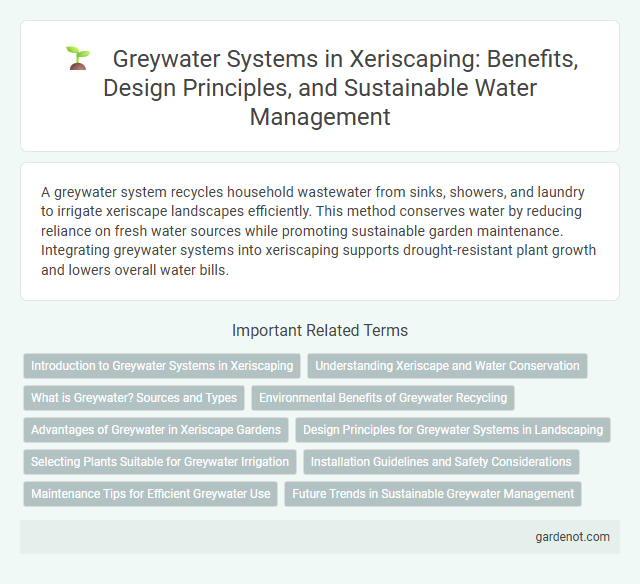A greywater system recycles household wastewater from sinks, showers, and laundry to irrigate xeriscape landscapes efficiently. This method conserves water by reducing reliance on fresh water sources while promoting sustainable garden maintenance. Integrating greywater systems into xeriscaping supports drought-resistant plant growth and lowers overall water bills.
Introduction to Greywater Systems in Xeriscaping
Greywater systems in xeriscaping recycle lightly used household water from sinks, showers, and laundry to irrigate drought-tolerant landscapes, significantly reducing freshwater consumption. These systems can decrease outdoor water use by up to 50%, promoting sustainable water management in arid regions. Integration of greywater irrigation supports native plant growth while minimizing the strain on municipal water supplies.
Understanding Xeriscape and Water Conservation
Greywater systems play a crucial role in xeriscape by reusing lightly used household water for irrigation, significantly reducing potable water consumption. Integrating greywater with drought-tolerant plants and efficient irrigation techniques enhances water conservation and supports sustainable landscaping. This approach aligns with xeriscape principles by maximizing resource efficiency and promoting environmental stewardship.
What is Greywater? Sources and Types
Greywater refers to gently used water from household activities such as bathing, laundry, and dishwashing, excluding sewage or blackwater from toilets. Common sources of greywater include sinks, showers, washing machines, and bathtubs, which generate water containing low levels of contaminants. Types of greywater vary based on origin and treatment requirements, typically classified as light greywater from sinks and showers and dark greywater from laundry or kitchen use, with different potentials for reuse in xeriscape irrigation.
Environmental Benefits of Greywater Recycling
Greywater recycling in xeriscape reduces freshwater demand by reusing water from sinks, showers, and laundry for landscape irrigation, conserving valuable water resources in arid regions. This system minimizes wastewater discharge into sewage systems, lowering pollution levels and protecting aquatic ecosystems. Implementing greywater systems also decreases the energy consumption associated with water treatment and distribution, contributing to a smaller carbon footprint.
Advantages of Greywater in Xeriscape Gardens
Greywater systems significantly reduce freshwater consumption in xeriscape gardens by recycling water from sinks, showers, and laundry, promoting sustainable irrigation practices. They enhance soil moisture retention and support plant health without overwatering, reducing the need for potable water sources. This efficient water management approach lowers utility costs and mitigates environmental impact in arid landscape designs.
Design Principles for Greywater Systems in Landscaping
Design principles for greywater systems in landscaping prioritize efficient reuse of household wastewater to minimize potable water consumption. Key elements include selecting low-toxicity cleaning products, ensuring proper filtration to prevent clogging, and maintaining systems to avoid health risks and soil contamination. Integrating greywater irrigation with drought-tolerant xeriscape plants maximizes water conservation and promotes sustainable landscape health.
Selecting Plants Suitable for Greywater Irrigation
Choosing plants for greywater irrigation requires selecting species that tolerate moderate salt levels and occasional nutrient variability, such as lavender, rosemary, and ornamental grasses. Drought-resistant and native plants perform well, minimizing water stress and ensuring sustainability in xeriscape landscapes. Avoiding edible crops and sensitive plants reduces the risk of contamination and supports environmental safety.
Installation Guidelines and Safety Considerations
Proper installation of greywater systems in xeriscape landscaping requires adherence to local codes, ensuring pipes and filters are securely connected to prevent leaks and contamination. Safety considerations include avoiding the use of greywater for edible plants and maintaining regular system checks to prevent pathogen buildup and ensure efficient water flow. Utilizing EPA-approved materials and designated distribution methods helps protect soil and plant health while promoting water conservation.
Maintenance Tips for Efficient Greywater Use
Regularly inspect and clean filters and pumps in greywater systems to prevent clogging and ensure optimal water flow. Avoid using harsh chemicals or detergents that can damage plumbing and harm plants irrigated by greywater. Routine monitoring of water quality and system components prolongs lifespan and maintains efficient greywater reuse in xeriscape landscapes.
Future Trends in Sustainable Greywater Management
Future trends in sustainable greywater management emphasize advanced filtration technologies and smart monitoring systems that optimize water reuse in xeriscape landscapes. Integration of AI-driven sensors enables precise control over greywater distribution, reducing waste and improving plant health with minimal human intervention. Growing regulatory support and innovations in biodegradable treatment materials further enhance the environmental benefits of greywater reuse in sustainable landscaping.
Greywater system Infographic

 gardenot.com
gardenot.com